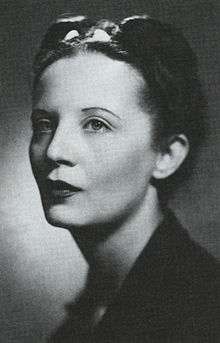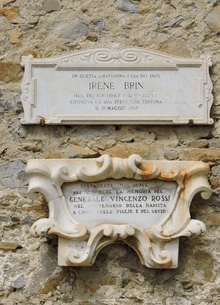Irene Brin
| Irene Brin | |
|---|---|
 Irene Brin | |
| Born |
Maria Vittoria Rossi 14 June 1911 Rome, Italy |
| Died |
31 May 1969 (aged 57) Bordighera, Italy |
| Nationality | Italian |
| Occupation | writer, fashion journalist and special consultant, gallerist |
| Years active | 1934–69 |
| Employer | Harper’s Bazaar, Omnibus, La Settimana Incom illustrata, etc. |
| Spouse(s) | Gaspero del Corso |
| Parent(s) |
|
| Relatives |
|
| Awards | Knight of Order of Merit of the Italian Republic |
| Website |
www |
Irene Brin, born Mary Victoria Rossi (Rome, 14 June 1911 - Sasso (Bordighera), May 31, 1969), was an Italian journalist and writer.
Biography

Maria Vittoria Rossi, better known by the name of Irene Brin, comes from a Ligurian family of educated[1] and progressive people. Irene's father was general Vincenzo Rossi, author of two military treaties very reputed in his days: "War in the mountains" (1902) and "The English expedition in Tibet" (1905). The mother, Maria Pia Luzzatto, was born and raised in Vienna, of Jewish origins and multilingual. She has given her two daughters passion for languages (she was fluent in five [1]), for art and literature.
Irene is also the niece of the criminal lawyer Francesco Rossi (1863-1948), who was also Mayor of Bordighera from 1901 to 1907, and the cousin of the lawyer Paolo Rossi that became Minister of Education, as well as Chairman of the Antimafia Commission and President of the Constitutional Court. She is also second cousin's with the daughter of Paolo Rossi, the writer Maria Francesca Rossi, known as Francesca Duranti.[2]
As early as 1934, aged twenty, Maria Vittoria Rossi made her debut in the columns of the newspaper "Il lavoro” (work) in Genoa, called by Giovanni Ansaldo (who in 1937 signalled her to the Leo Longanesi as a columnist for the new weekly "Omnibus (1937)"), under the pseudonym Mariù, then changed into Oriane as a tribute to Oriane de Guermantes, the character created by Marcel Proust.
The meeting with Gaspero del Corso
Already engaged to a close friend of Indro Montanelli, the Genoese Carlo Roddolo, who died on February 18, 1937 in Addis Ababa, she met at a dance at the hotel Excelsior in Rome, Gaspero del Corso, a young officer with whom she discovered to share the intense passion for Marcel Proust, for art in general and for travel. It was love at first sight, so that the two were married after a few meetings.[3]
It’s in 1937 that Maria Vittoria Rossi became Irene Brin: the name she was given by Leo Longanesi, who invited the journalist to collaborate with the weekly rotogravure "Omnibus (1937)", in which there was - novelty at the time - a section of society news written with malice and refinement.[4] Irene Brin undertook this activity in parallel to frequent trips with her husband: trips that led the pair to engage in relationships with the best cosmopolitan society. In 1941 she wrote her first book "Olga in Belgrade", inspired by her experience during the war in Yugoslavia.
War
In 1943 the couple returned to Rome. Formally after the armistice Gaspero del Corso was a deserter and he then hid in the house, along with forty other officers and disbanded soldiers to avoid the German roundups.
At that time their only income came from the fees for translations of Irene which were, however, more and more scarce as Irene stopped working for publishers who were collaborating with the occupiers. So it was that Brin started to sell their wedding gifts: at the first an alligator bag, and then prints and drawings of artists like Picasso, Matisse, Morandi ...[5]
Shortly after Irene Brin found a job as a saleswoman in the art library La Margherita , assisted by her husband who, under the false identity of Ottorino Maggiore, procured the books, drawings and customers. On their activities, there an excellent story by the American Henry Furst The death of Mozart (Longanesi, Milan 1957).
The Gallery ‘’L’Obelisco’’
During the activities at La Margherita Irene met an unknown artist, Renzo Vespignani, with a large portfolio of drawings. Irene and Gaspero bought in their jobs and resold them in a very short time, thus confirming their vocation of merchants; this was their first purchase and also the first sale for Vespignani.
In 1946 the couple rented a room in Via Sistina 146 and founded "The Gallery L’Obelisco of Gaspero and Maria del Corso",[6] which soon became of primary importance in the cultural landscape of the capital, as can be seen from the many art shows they organized over time.[7]
La Settimana Incom
Immediately after the war, Irene Brin began a long collaboration with La Settimana Incom illustrated of Luigi Barzini, Jr., the printed version of the most famous newsreel after the war. On those pages Irene, with the excuse to dispense advice to readers of style, behaviour, social life, fashion and so on, produced tiny pieces rich in irony and non-obvious literary quotations, understandable to an audience cultured and refined. Her articles were signed with the pseudonym Contessa Clara Ràdjanny von Skèwitch, a character impersonated by Irene who pretended to be an old, aristocratic exile from an unspecified country behind the Iron Curtain, citing episodes here and there such as meetings with Royal Highnesses and famous writers. Thus, under “sleep”, she mentioned a conversation between on insomnia between Henri Bergson and Marcel Proust, while, under “taxi”, she recalled a meeting with a childhood friend, exiled in Paris, who made ends meet doing this job. The character of the Countess Clara inspired to Alberto Sordi a radio parody of Count Claro.[8]
Harper's Bazaar
Irene also personified the ideal of perfect style she was writing upon. In 1950, walking on Park Avenue with her husband, she was stopped by a lady who asked her where ever she could buy a dress so classy (it was designed by Alberto Fabiani). So it was that Irene became acquainted with Diana Vreeland, editor in chief of Harper's Bazaar for which she was the first Italian to work, bringing in the pages of New York the first signs of Made in Italy , at a time when the fashion world spoke only French.
Irene worked actively to the success of the first Italian fashion show organized on February 12, 1951 by the Marquis Giovanni Battista Giorgini at his private residence in Villa Torrigiani in Via de 'Serragli in Florence; and of the second in July 1952 that took place in the White Hall of Palazzo Pitti[9]
Cultural exchanges
In their frantic activity in Rome and around the world, Irene and Gaspero ‘’L’Obelisco’’ hosted dozens of famous or emerging artists, destined for a great future; and likewise they brought Italian art in the main American and European cities.
The last days
Upon learning that she was suffering from an incurable disease, Irene reacted continuing her work activities and travel as before; in the spring of 1969, the couple went as usual to Strasbourg to visit the local art exhibitions. On the way back, not being able to continue the trip to Rome, Irene decided to stay in her family house in Bordighera, where she died on May 31.
Honours

On 2 June 1955 she was named “Knight Grand Cross of Order of Merit of the Italian Republic” by the List of Presidents of Italy, Giovanni Gronchi for “the success and development of Italian fashion in the world” [10]
Bibliography
- Olga a Belgrado, Vallecchi, Firenze 1943
- Usi e Costumi, 1920-1940, Donatello de Luigi, Rome 1944
- Le Visite, Casa Editrice Partenia, Rome 1944
- Images de Lautrec, Carlo Bestetti Edizioni d’Arte /Collezione dell’Obelisco, Rome 1947
- Femmes de Lautrec, Carlo Bestetti Edizioni d’Arte /Collezione dell’Obelisco, Rome 1954
- I Segreti del Successo, Colombo Editore, Rome 1954 (as Contessa Clara)
- Il Galateo, Colombo Editore, Rome 1959 (as Contessa Clara)
Further reading
- Irene Brin: lo stile italiano nella moda di Vittoria Caterina Caratozzolo, Marsilio, Venice 2006
- Mille Mariù. Vita di Irene Brin di Claudia Fusani, Castelvecchi Editore, Rome 2012, con prefazione di Concita De Gregorio
Notes and references
![]() Media related to Irene Brin at Wikimedia Commons
Media related to Irene Brin at Wikimedia Commons
- 1 2 Tornabuoni, Lietta. Irene Brin, Usi e costumi 1920-1940 . Sellerio. p. 234.
- ↑
- ↑ Lietta Tornabuoni in notes to: Irene Brin, Customs 1920-1940, Ed. Sellerio, pp. 231-232
- ↑ On relations with Longanesi, Irene wrote, in the death of his friend, an excellent article on the "Il Borghese" of September 27, 1957: A name invented
- ↑
- ↑
- ↑
- ↑ Lietta Tornabuoni in notes to: Irene Brin, Customs 1920-1940 , Ed. Sellerio, pp. 230
- ↑
- ↑ Sito web del Quirinale: dettaglio decorato.